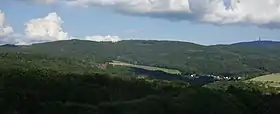Waldems | |
|---|---|
 Protestant church in Esch | |
 Coat of arms | |
Location of Waldems within Rheingau-Taunus-Kreis district  | |
 Waldems  Waldems | |
| Coordinates: 50°15′N 08°20′E / 50.250°N 8.333°E | |
| Country | Germany |
| State | Hesse |
| Admin. region | Darmstadt |
| District | Rheingau-Taunus-Kreis |
| Government | |
| • Mayor (2021–27) | Markus Hies[1] (CDU) |
| Area | |
| • Total | 36.68 km2 (14.16 sq mi) |
| Elevation | 398 m (1,306 ft) |
| Population (2022-12-31)[2] | |
| • Total | 5,160 |
| • Density | 140/km2 (360/sq mi) |
| Time zone | UTC+01:00 (CET) |
| • Summer (DST) | UTC+02:00 (CEST) |
| Postal codes | 65529 |
| Dialling codes | 06126, 06087, 06082 |
| Vehicle registration | RÜD |
| Website | www.gemeinde-waldems.de |
Waldems (German pronunciation: [ˈvaltˌɛms]) is a municipality in the Rheingau-Taunus-Kreis in the Regierungsbezirk of Darmstadt in Hesse, Germany. The municipality's administrative seat is Waldems-Esch.
Geography


Location
Waldems is located in the Taunus in a widely wooded setting at the northwest foot of the Feldberg massif at 250 to 629.3 m above sea level, the southern hilltop of the mountain Windhain, which is the highest point of the district Rheingau-Taunus-Kreis, rising east of the constituent municipality of Wüstems.
Neighbouring communities
Waldems is the easternmost municipality in the Rheingau-Taunus-Kreis and borders in the northeast on the municipality of Weilrod, in the east on the municipality of Schmitten, in the southeast on the municipality of Glashütten (all three in the Hochtaunuskreis), in the south and west on the town of Idstein (Rheingau-Taunus-Kreis) and in the northwest on the town of Bad Camberg (Limburg-Weilburg).
Constituent communities
The municipality's six Ortsteile are Bermbach, Esch (administrative seat), Niederems (with Reinborn), Reichenbach, Steinfischbach and Wüstems.
History
Although traces of settlement go far back, the current places in the municipality go back to clearing in Frankish times.
The first of the constituent communities to have a documentary mention was Bermbach, which was named as Barenbach in a document from the Lorsch codex in 772. For many centuries this was borderland; the Limes ran nearby, and later, the Electoral Mainz's, Hesse's and Nassau's spheres of influence all came up against each other here. From 1276 to 1570 the village was bound to the noble family of the Lords of Bermbach. Later, Bermbach was mentioned in connection with the persecution of witches and the legendary Schinderhannes (1801).
The constituent municipality of Esch goes back to a settlement from the 6th century, having had its first documentary mention as Eschze in the rent register of the archive deacon at Dietkirchen. Esch lies at the junction of the ancient Frankfurt-Limburg-Cologne trade road and the linking road between the Rhine and the Wetterau, and thereby always had a high traffic volume.
The story of how Niederems came to be can be traced back to 1274. Through hunger, pestilence and wars, the population figure was always very low. In particular, the Thirty Years' War reduced the number of households considerably.
Settlement in Reichenbach can be traced back to pre-Christian times. Worth mentioning are the barrow “Goldkessel” and the Celtic circular rampart. In 1428, the place was mentioned as Richinbach in the annals of Nassau-Idstein. In 1772, a fire destroyed the old village centre, although this was quickly rebuilt. From 1604 to 1968, Reichenbach had its own school.
Near the constituent municipality of Steinfischbach are found in the form of the barrows Totenkopf and Goldkessel clues to an early settlement. The village had its first documentary mention in 1156 under the name Vispach in a document from Archbishop Arnold of Mainz. Nearby there were iron ore prospecting and a quarry for millstones, road gravel, cobblestones and border stones.
Wüstems was mentioned in 1435 as Wosten Emsse in a record by Cuno von Reifenberg. The name's first syllable, Wüst, likely derives from Wüstungen (German for “abandoned settlements”) and refers to a forsaken village or rural area. The name of the brook, Ems, is from Old High German Ohm. Both these name elements point to a settlement period lasting more than 2,000 years. Also pointing to such a thing is the Celtic circular rampart on the nearby Taunus peak, Burg.
In 1806, the municipal area belonged to the Duchy of Nassau. In 1866 it passed to Prussia.
In the framework of municipal reform in Hesse, the hitherto self-governing communities of Bermbach, Esch, Niederems, Reichenbach, Steinfischbach and Wüstems merged in 1972 into today's greater municipality of Waldems.
Politics
Municipality council
The municipal election held on 26 March 2006 yielded the following results:
| Parties and voter communities | % 2006 |
Seats 2006 |
% 2001 |
Seats 2001 | |
| CDU | Christian Democratic Union of Germany | 29.2 | 8 | 26.7 | 8 |
| SPD | Social Democratic Party of Germany | 34.3 | 9 | 37.3 | 12 |
| GREENS | Bündnis 90/Die Grünen | 10.0 | 3 | 6.4 | 2 |
| FDP | Free Democratic Party | 4.0 | 1 | 3.1 | 1 |
| FWG | Freie Wählergemeinschaft | 16.1 | 4 | 20.3 | 6 |
| UWK | Unabhängiger Wählerkreis | 6.3 | 2 | 6.2 | 2 |
| Total | 100.0 | 27 | 100.0 | 31 | |
| Voter turnout in % | 52.2 | 58.0 | |||
Town partnerships
The municipality of Waldems maintains partnerships with the following places:
 Saint-Bonnet-en-Champsaur, Hautes-Alpes, France since 1982
Saint-Bonnet-en-Champsaur, Hautes-Alpes, France since 1982 Szikszó, Borsod-Abaúj-Zemplén County, Hungary since 1997
Szikszó, Borsod-Abaúj-Zemplén County, Hungary since 1997
Economy and infrastructure
Formerly, the villagers drew their livelihood from agriculture and forestry. In the latter half of the 20th century, though, Waldems converted itself into a residential municipality. Most workers earn their living, by way of the good transport links, in the Frankfurt Rhine Main Region.
Transport
The municipality is well linked to the long-distance road network through the Idstein Autobahn interchange on the A 3 (Cologne–Frankfurt), 8 km away. Furthermore, Bundesstraßen 8 and 275 run through the municipal area, crossing in Esch.
The nearest railway station is in Idstein on the Main-Lahn Railway. Stopping here is, among others, RMV line 20.
References
- ↑ "Ergebnisse der letzten Direktwahl aller hessischen Landkreise und Gemeinden" (XLS) (in German). Hessisches Statistisches Landesamt. 5 September 2022.
- ↑ "Bevölkerung in Hessen am 31.12.2022 nach Gemeinden" (XLS) (in German). Hessisches Statistisches Landesamt. June 2023.